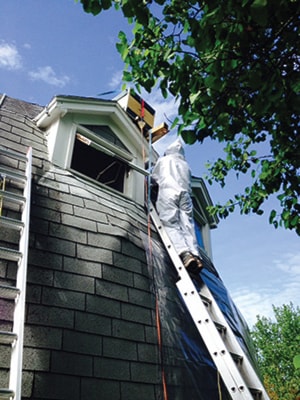Thousands of swarming bees were sucked out of the rafters of a Blackfalds home on Tuesday.
All it took was an innovative “bee vac” that was linked by a tube to a homemade wooden hive — both created by Stephen Deering.
The Clive-area fledgling beekeeper was only too happy to take the estimated 20,000 unwanted bees out of the house of Blackfalds couple Cheryl and Wade Morgan and into a new hive he later relocated to his own acreage.
Deering shrugged off his efforts as “a change of hobby.”
He said his interests recently switched from breeding tropical dart frogs to honey production and bee breeding — which is also proving educational for his three children.
The Morgans, who were astonished to discover the swarm while redoing the roof of their dome-shaped home on Sunday, were put in touch with Red Deer Beekeepers. Deering, a member of the new group that promotes and supports urban beekeeping, came to their rescue.
“We are so thankful to have found someone like him to help us,” said Cheryl. She had previously told a local TV station she feared the bees were turning their home into “one humongous hive.”
Deering, a power engineer at Joffre, had read about three different methods of getting rid of swarming bees: using a lemongrass scent to lure bees away from a property; employing a funnel-shaped net to allow the insects to get out of a place, but not back in; and using a bee vacuum.
He thought the latter would be the most efficient method. Deering built the contraption on Monday, using an old shop vac motor and tube that he punctured with two extra holes to slow down suction so the bees would be uninjured.
Even though swarming bees are docile, he put on his beekeeper suit to avoid getting stung and falling from the roof. “I didn’t want to get hurt.”
With two ladders, Deering scaled the side of the house’s dome on Tuesday and secured the heavy bee vac to the roof. He then opened a dormer window and began vacuuming up bees.
The buzzing pollinators, which Cheryl described as “surprisingly calm,” went through the tube and into the wooden hive at the other end. “It was very time-consuming and at times, his gloved hands were covered in bees,” she recalled, but the method worked well.
Deering estimated he lost less than 10 bees out of a mass the size of a volleyball.
“It was quite an amazing experience,” recalled Cheryl.
Deering had hoped to find the queen bee within the honeycombs the bees had already started under the roof. But he didn’t. “I may have vacuumed her up,” said the Central Albertan, who took the full hive back to his own acreage, where he already had been keeping two hives.
The new bees, which he estimates collectively weigh from 1.3 to 1.8 kg (three to four pounds), now make it three hives.
Deering said it’s unknown whether the swarming bees came to the Morgans’ Blackfalds residence from a nearby commercial honey operation or were just “feral” bees that had previously lived in wild hives and relocated.
Beekeepers are supposed to keep a close eye on colonies to ensure the bees aren’t growing out of their existing hives, said Charity Briere, chair of Red Deer Beekeepers. If a hive becomes too crowded, the bees will produce another queen and split, with some of the insects setting out to find a new home.
Briere, who keeps her bees in a friend’s yard in Red Deer, believes urban beekeeping can be a win-win situation — beekeepers get honey and neighbours get better garden yields from their proximity to pollinating bees.
For more information, email reddeerbees@gmail.com.
lmichelin@www.reddeeradvocate.com
